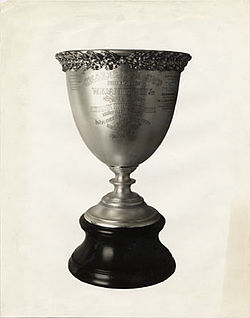Vanderbilt Cup Race
 |
|
| Country |
|
|---|---|
| Inaugural season | 1904 |
| Folded | 1968 |
The Vanderbilt Cup was the first major trophy in American auto racing.
An international event, it was founded by William Kissam Vanderbilt II in 1904 and first held on October 8 on a course set out in Nassau County on Long Island, New York. The announcement that the race was to be held caused considerable controversy in New York, bringing a flood of legal actions in an attempt to stop the race. The politicians soon jumped in, holding public hearings on the issue. Vanderbilt prevailed and the inaugural race was run over a 30.24 miles (48.7 km) course of winding dirt roads through the Nassau County area.
Vanderbilt put up a large cash prize hoping to encourage American manufacturers to get into racing, a sport already well organized in Europe that was yielding many factory improvements to motor vehicle technology. The race drew the top drivers and their vehicles from across the Atlantic Ocean, some of whom had competed in Europe's Gordon Bennett Cup. The first Long Island race featured seventeen vehicles and the newspaper and poster art promotion drew large crowds hoping to see an American car defeat the mighty European vehicles. However, George Heath won the race in a Panhard and another French vehicle, a Darracq, took the Cup the next two years straight. Crowd control was a problem from the start and after a spectator, Curt Gruner, was killed in 1906, the race was cancelled. Meanwhile, in France, the first Grand Prix motor racing event had been run on June 26, 1906, under the auspices of the Automobile Club de France in Le Mans. One of the competitors was American Elliot Shepard, the son of Margaret Vanderbilt-Shepard and a cousin of William Kissam Vanderbilt.
Learning from his cousin about the success of the French Grand Prix and the rapid expansion of Grand Prix racing in other European countries, William Vanderbilt conceived a way to solve the safety issue as well as improve attendance to his race. Vanderbilt formed a company to build the Long Island Motor Parkway, one of the country's first modern paved parkways that could not only be used for the race but would open up Long Island for easy access and economic development. Construction began in 1907 of the multimillion-dollar toll highway, to run from the Kissena Corridor in Queens County over numerous bridges and overpasses to Lake Ronkonkoma, a distance of 48 miles (77 km). The 1908 race was held over parts of the new highway and much to the delight of the large crowd on hand, 23-year-old local hero George Robertson from Garden City, New York became the first American to win the event driving the American Locomobile (built in Bridgeport, Connecticut) (in 1908, George Robertson (wearing #16) took the win in this car, ahead of fellow Locomobile pilot Joe Florida in third, becoming the first United States-built car to win in international competition).
...
Wikipedia
